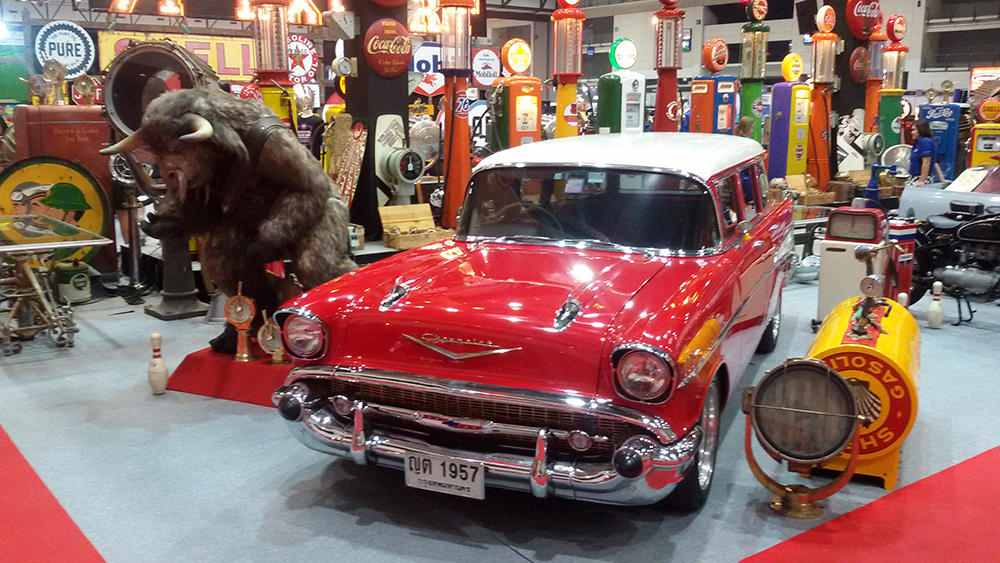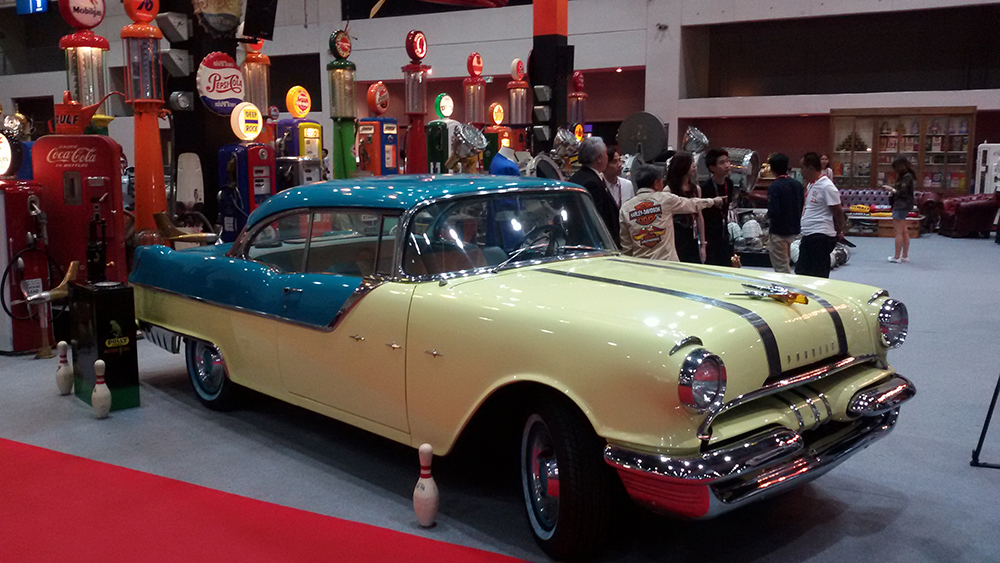’60s and ’70’s were about freedom and searching
Classic: different – not mundane – timeless.
The Vietnam War heralded decades of change for car lovers in Thailand. Willy’s Jeep was a common sight in 60’s Bangkok. American culture as well as G.I.’s were transported into the heart of Thailand. Music, movies and lifestyles “as seen in the movie theater” stormed Bangkok and other big cities around the country, introducing the power of Chevrolet, Plymouth and Dodge. Also were the elegant tail fins of Cadillac and the authoritative Buick. Ford Mustang grasped the leading position in streetcar racing.

British influences waned after WW2 and ironically, the deadliest enemy of the Austin A35, Ford Thames, Consul and Corsair were Japanese cars such as Datsun Bluebird and the Toyopet Tiara. These small Japanese machines defeated the competition, especially the competitive taxi battlefield of Thailand.
The British survivors were Rolls-Royce, which was the vehicle of choice for the Lord Mayor of Bangkok. Jaguar was very popular as a racing car of Prince Bira and was the common choice of the well-heeled gentlemen who studied in Europe.
The small British sports cars in the Elvis Presley movie “G.I. Blues” helped MGA and Triumph rocket to stardom.
The names soon to be cast to oblivion were Morris, Riley, Wolsely, Armstrong-Siddeley, Hillman and Vauxhall, leaving only the Ford Escort to continue fighting alone in many rallies and of course the Austin Mini was immensely popular with the youths of the day.

The French showed their futuristic perspective in the strange looking Citroen DS/ID as well as their artful clean and speedy Peugeot 404. The rear-engined Renault Dauphine which was succeeded by the R4 which turned out to be her trump card and one of the first family hatchbacks. French cars have always enjoyed something of a cult status among professionals, as the models were always understated. Simca started with the FIAT 500 clone then the clean lines and beauty of the Simca-Aronde, with its typical French look.
When Dr. Heinz Nordhoff from Volkswagen came to Thailand seeking a distribution partner for his famous product he was surprised to broker a deal within the first few days with His Highness Rangsit who was fluent in the German language as he had been educated in Zurich. The deal was made at the front desk of the famous Oriental Bangkok and was to last twenty years.
VW was cleverly named “Taotong” meaning “Golden Bug” and could be a synonym of a “Golden lovely Turtle” in Thai, this helped characterize the type 1 VW into a well-loved vehicle.
Mercedes Benz 300 came to the attention of Thais with her flamboyant manner and outstanding performance, which equaled any American cars. When they added the 190 SL to the line, Thonburi Panich the sole agent for Mercedes climbed to the top of the country car society, and could only be purchased by cash. BMW was struggling after World War II but finally presented its Isetta “Bubble car” then the 700 the car with 2 cylinders and 700cc motorcycle engine and then the sporty “Neue Klasse” as a sign of her revolution. These were greatly admired by the younger motorists for blending Italian styling with German engineering and expertise.
It’s interesting to know that the great success of BMW in Thailand today started as a business from a shop house showroom in the early ’50’s.
Opel was well known as a runabout car of HRH Crown Prince Vajiravudh since late 1910. Known for her durability, ease of maintenance and tough body, it was below the Mercedes in the market and had a cult status with professionals. But the most recognized German small car was the Ford Taunus 12M, and they always seemed to be driven by young beautiful Thai ladies.
Italian cars were always in vogue such as Alfa Romeo, Lancia and FIAT. With the FIAT 500 Jolly starring in the Thai movie “Tone”.
Prince Bira, the most famous Thai racing driver, drove his Maserati 250F in many Grands Prix of the ’50’s emphasizing the sporty nature of all the Italian cars, and the Prince ended up having a FIAT dealership. His legacy was remembered with the Special Series FIAT1100 B.P. Sport (Birabhongse Sport).
But no one can make an argument on the status of Alfa Romeo, the car from Milano that sat at the top of the wish lists for all young men, even of the professional driver. The Alfa Romeo 105 series is the all-time Superstar for Thai car lovers. Her features, like DOHC, 5-speed-transmission (with that heavy clutch operation), limited slip differential and sodium-cooled valve stems were the alien modifications not even heard from in any other brands. The only downside was the rust.
Lancia was popular with those with a more artful taste and the Aurelia B20’s appearance in Thai movies showcased her beautiful body. Also worth mentioning are the Fulvia V4 and Fulvia Zagatto.
The “Japanese invasion” began in the 60’s, the market was overwhelmed by low price cars, which were less demanding financially and had a long service life.
This gave them the upper hand for the next 20 years, first from public transportation such as taxis and trucks then to small cars and eventually middle and larger passenger cars. Toyota led the way when she founded her Thai assembly line in the mid ’60’s with huge success.
Publica 700, 1000 and Corolla were pumped out and created the expansion of the market. Also starring in larger cars, sales figures were not less for the importing Toyopet Tiara, Toyota Corona and Crown. Nissan under the name of Datsun with a strong Thai team raced to have a local assembly line and had great success with its Sunny and Bluebird that were modeled on the Austin.
After the Japanese successful attack in the taxi wars, the next brands marching into the Thai market were Mazda (Luce – the first Japanese to have mass OHC in this market), Mitsubishi (under the name of Colt and Galant, that had a much notorious GTO), lsuzu (the rare Bellett) and Daihatsu (a small commercial 3 wheeler, ancestor of all the Tuk-Tuks).
The car scene from the ’60s to the ’70’s was about freedom and searching, some automakers were in “trial and error” that could be called “in development”.
Those perfect conditions created crisp and fresh products, not perfect but rather romantic.
That period of time could not happen again. It’s brought us many memorable cars, cars that haven’t grown old with time, pieces of art that made you look twice at them, which is a good definition of the “classic car” – the things of all time.
For more information about meetings and location please visit: www.classic-car-friends-pattaya.com FACEBOOK/ classic-car-friends-pattaya




